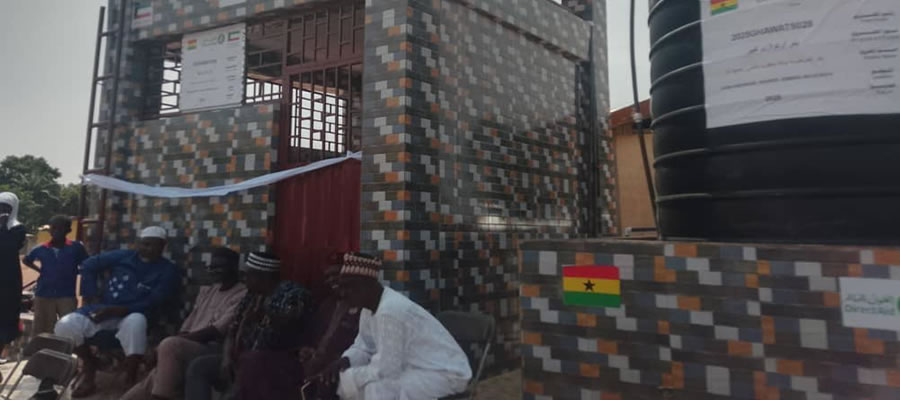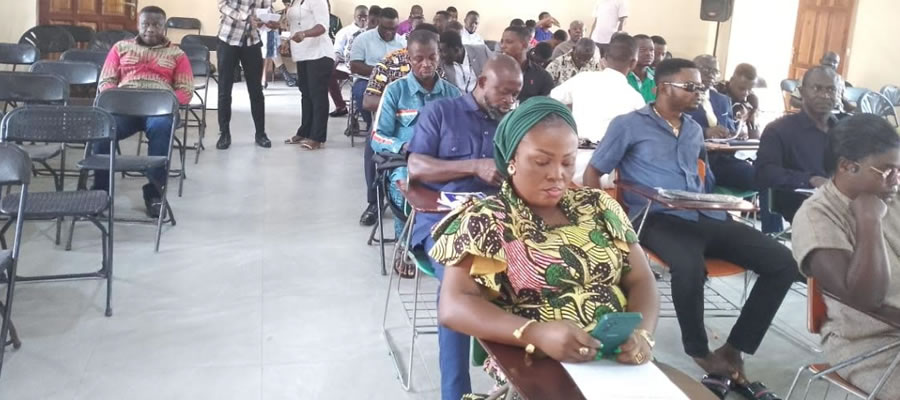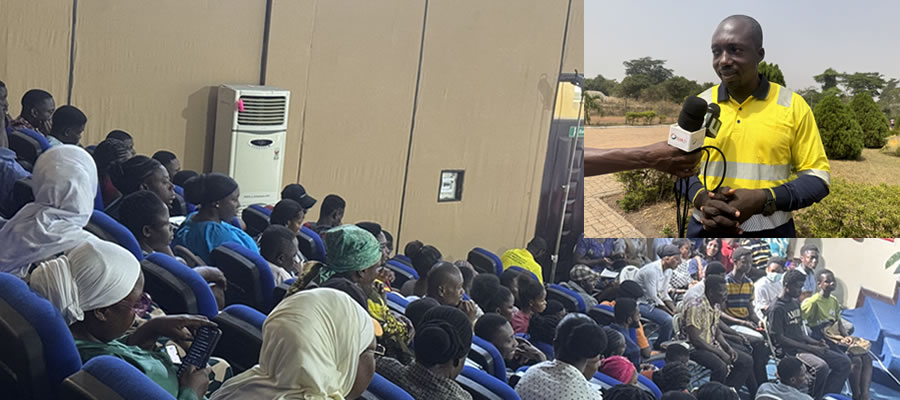

The strategy to improve production and generate gainful employment is based on creating an enabling environment to stimulate private sector activities. This will involve improvement of the capacity of the private sector to adopt an entrepreneurial approach to increase productivity and generate employment. This will be based on the data collected from the District.
The programme on production and employment will seek not only to improve public sector delivery of programmes but also provide sufficient incentives to stimulate private sector activities in increasing and sustaining production of basic staples, production of selected export crops, and vigorously expand employment in sectors such as tourism which can employ and enhance the skills of people in geographical areas where the poor reside most.
The production and gainful employment considered under the GPRS seeks to promote improved output levels in the various sectors of the economy (Agriculture, Industry and Service) and also promote employment. The high level of unemployment recorded in the country needed efforts to be geared towards the problem to raise the standard of living of Ghanaians. The engagement of people in employment and production will also reduce the high incidence of social vices in the country. Production and Gainful Employment considered in this report entail a look at the structure of the economy, employment status in terms of the population in the Ejisu-Juaben Municipal employed and unemployed, gender and employment, income and employment and the causes of unemployment in the Municipality.
A further look at the sectors of the economy was also done. This is because; the sectors of the economy are interrelated and interdependent on one another for growth and development. Therefore, the development of one leads to the other. Under the agricultural sector, the methods of farming in the Municipality, major crops grown in the district, the marketing of produce the types of storages facilities for crops, incidence of post harvests, livestock production levels and the major animals kept were analyzed.
The development problems, suggested solutions and the development priorities under the agriculture sector have also been outlined for efforts to be focused on. A further look at the average income per the agriculture sector has also been done. For the industrial sector, a look at the types of industries engaged in, the contribution of the industrial sector to employments and income. The initial source of finance for the industrial sector has been done. Under the service sector of consideration include, the types of service rendered the performance of the sector in terms of it contribution to income and employment, the marketing strategies, the various financial institutions and its function as well as the development problems and priorities of the sector.
Structure of the Economy
The structure of Ghana’s economy remain little changed since independence. The economy remains fragile and very vulnerable to internal and external shocks in the formal sector. The structure of the Assembly’s economy remains an agrarian one. This shows that the agriculture sector dominate in terms of employment. In this section structure of the economy of the Assembly has been considered under contribution of the sector to employment, income level of the incidence of poverty in the Municipality.
Contribution of the Sectors to Employment
The sectors of the economy (agriculture, industry and service) each contribute to employment. It is in these sectors that people are engaged in production and service in the Municipality. There is therefore the need to consider the proportion of people employed by each of these sectors of the economy in order to ascertain the sector that contributes greatest to employment. Based on the outcome of this analysis, valid deductions could be made for planning decisions. Below is a distribution of the contribution of the sectors to employment in the Municipality.
From the table above, it could be deduced that, agriculture is the leading employer of the working population employing 68.2% of the people whiles the industrial sector is the least employer of the working population employing 8.0% of the populace. The service sector also employs 23.8% of the population. It could therefore be said that, there is less emphasis on diversification in the Municipality since there is a great percentage difference between the leading employer of the population and the other sectors.
Thus, if diversification was been emphasized on, the percentage difference between the leading employer and the next in order would not have been so wide. It could further be said that, there is availability of fertile soil in the district which attracts most of the people into that sector. Further, it could be said that, the industrial sector has received little attention in terms of it ability to contribute high to employment.
Income Distribution of the Sectors
Another component of the structure of the economy that was looked at is the income distribution of the sectors. There is the need to look at each sector’s contribution to income by the sectors in order to come out with the sector that contributes highest to the economy and to know the sector that is highly lucrative in the Municipality. It is on these bases that income distribution of the sectors was considered.
A look at the income distribution table shown above depicts that, it is the service sector that contributes highest to the income in the district giving ¢564,613 per month whiles the agricultural sector is the least contributor to the economy giving ¢455,825 per month. Even though most of the people within the district are engaged in agriculture, its contribution to income is very low thus contributing to the low living standards of the people. The service sector can therefore be used in the fight against poverty in the municipality if it is boosted.
Incidence of Poverty in the Respective Sectors
Poverty is a social canker in most developing countries and Ghana is no exception. The Ejisu-Juaben Municipal Assembly was looked at in the context of its poverty level and incidence which constitute component of the structure of the economy. This was looked at in the context of the sectors of the economy (agriculture, industry and service). Poverty can be put into categories. Those considered not poor and those considered poor. To be classified as not poor means one must earn annual income above ¢900,000.
To be considered poor means the annual income is below ¢900,000 From the table, it could be deduced that it is in the agricultural sector that majority of the people (37%) earn income below ¢900,000 per annum. This shows that, the agriculturalists in the district are poorer than those in the service and industrial sectors. Those who are considered not poor (thus earning annual income above ¢900,000) are mostly the service sector employees, constituting 82%. This shows that the service sector is the most gainful employer among all the sectors of the economy.
Gainful Employment
Gainful employment basically concerns the creation of the enabling environment for accelerated growth and development. It seeks to promote a higher level of income among all the sectors of the economy that will make them gainfully employed thereby increasing the standard of living of the people and reducing the poverty level. It concerns itself with the employment status and deals with the proportion of people employed and unemployed, gender and employment, sector gender employment.
Proportion of People Employed and Unemployed
This shows the percentage of people employed and unemployed in the district. The essence is to know the total number of people who are employed and unemployed in the district. By this, efforts could be directed at reducing the unemployment rate if it is high. Further, a look at the proportion of the employed to the unemployed will show the economic dependency ratio. This will show the number of people depending on a working person. It will further reveal whether standards of living are high or not. The proportion of the people employed and unemployed in the District has been depicted below: Table proportion of people and unemployed.
From the table, an economic dependency ratio of 1:0.9 could be deduced as the existing ratio of economic dependency. This low economic dependency ratio has an implication for planning which is low pressure on the employed population in the district and hence an ability to meet basic needs and make savings for future investments.
Gender and Employment
Gender and employment makes comparism between the male and female ratio employed in the district. By this analysis, it could be deduced pictorially the number of males who are employed as against the number of females who are employed for planning implications to be drawn for development. Below shows the gender and employment situation in the district:
The table above shows a high female unemployment rate of 62.5% as against a male unemployment rate of 37.5%. It could therefore be said that, there is the existence of female vulnerability since the number of females who are unemployed far exceed the number of males who are unemployed. Planning efforts could therefore be made in line with the GPRS theme of reducing women vulnerability.
Household Income Levels
The household incomes of the people of the Municipality have also been identified. The income per month gives an understanding of the purchasing power of the people and their ability to meet / satisfy their basic needs. By this income levels, the incidence of poverty in the district could also be deduced. Thus, outlining the number of the people earning between specific ranges of income. The average household income for the people of District is ¢387,709 per month. The household income levels of the district are given in a tabular and pictorial form below:
Household Expenditure Pattern
Household expenditure distribution has been given. It shows how the expenditure of households in the Municipality is distributed. That is amount spent on items per month. By this analysis, the item which takes most of the households’ income is deduced. The household expenditure pattern per annum is given below:
From the table, households in the district spent more of their income on food than on any other item. The least item income is spent on is shelter on is shelter. The reason is that, most of the houses are inhabited by the owners themselves and their family members, and rents are also low.
Income Distribution
From the socio economic survey conducted, September, 2005, in the Ejisu-Juaben District, the analysis revealed that, the average monthly income for the District is 0415,559. The distribution of income in the district was further analyzed using the Lorenz curve. The Gini coefficient was found to be 0.4, which implies that incomes are not equitably distributed in the district.
Poverty Levels
Poverty is defined as the economic condition in which people lack sufficient income to obtain certain minimal levels of health services, food, housing, clothing, and education generally recognized as necessary to ensure an adequate standard of living. What is considered adequate, however, depends on the average standard of living in a particular society. The Ghana Living Standard (1999) has established the poverty line as within the upper limit and the lower limit. The Ghana Living Standards Survey derives two nutrition-based lines of poverty. The poverty line is the consumption expenditure needed to achieve minimum nutritional needs. Overall poverty is based on an upper poverty line of 900,000 cedis per adult per year. Extreme poverty is based on a poverty line of 700,000 cedis per adult per year.
From the Lorenz curve, the Gini-coefficient of 0.4 is more close to perfect inequality and it can be seen that, 50% of the people possess only 10% of the income of the district. It can therefore be said that, there is unequal distribution of income in the district which is an indication of poverty within the district. The analysis of the incidence of poverty within the sectors of the economy reveal the following; about 36.4% of those employed in agriculture are not poor, 12.1% are poor and 51.5% are very poor. In other words five out of every ten farmers in the district are very poor.
In the service sector, 48.4% are not poor, 18.8% are poor and 32.85 are very poor. In the industrial sector, 63.2% are not poor, 15.8% are poor and 21% are very poor. From these analyses it can clearly be observed that the agricultural sector is worst hit by the incidence of poverty, that is, 51.5% are very poor.
In all, about 49.3% of the districts population is considered to be not poor by the standard above, 15.6% are poor and 35.1% are very poor. This means that about five out of every ten people in the district are poor/very poor. This is slightly higher than the regional figures where 30% or three out of every ten people are poor/very poor (source: GPRS, 2002-2004).
Household Income and Expenditure Pattern
Housing Income per month
The table shown above is a reflection of income status of household. It can be seen that between ¢481000-¢2000000 a month and 20.3% earn above ¢2000000. This implies that the people are middle income earns and only development target should be geared towards the middle income earners, however not to the negligence of the other groups of income earners.
Source of Household Income
Income is earned from different sources as depicted in the table above. It can be seen that 0.7% earn their income their income from rent, 58.7% earn their income from profit accruing to then after their wages and salaries and 9.3% receive remittance from either relevant or friends living aboard or living outside. This means any development activity that is to take place or any credit facilities should be target at this group of income earner however the other groups are not to be neglected.
Investment And Business Potential
The Ejisu-Juaben Municipal Assembly has enormous opportunities for private investment and partnerships between the public and private sectors, predicated on the district’s large natural and human resources, as well as the solid infrastructure the Assembly has put in place.
In the agricultural sector, which absorbs about 55% of the labour force, the cultivation of non-traditional crops such as ginger, pineapple, black pepper, garden eggs, yam and sunflower, is suitable throughout the district. Indeed, large-scale cultivation of sunflower and other crops throughout the district is actively encouraged and supported by the Assembly.
Vegetables such as pepper, tomatoes, garden eggs and cabbages are also grown on a large scale.The cultivation of tree crops such as cocoa, oil palm, oranges, coffee, cola, guava and cashew, as well as the establishment of woodlots, is also heavily favoured.Almost every community in the district today has, at least, five hectares of land under woodlot and the district ranks very high in tree and food crop cultivation among the districts of the Ashanti Region.
In all these, both the soil and the weather conditions confer comparative advantages that make the sector look so attractive to potential investors. The Municipal is well endowed with gold and other mineral deposits.Currently, gold prospecting is going on at Achiase, Wobiri and Juaben to ascertain the economic and financial viability of exploiting these deposits.
There are also some stone deposits at Boankra and Ejisu. Clay deposits also abound at Hwereso and Donyina with the former found to be commercially viable for the establishment of brick, tile and pottery industries. The industrial sector is the least developed. This takes nothing away from the sheer potential that the industrial sector has to offer potential investors the in Ejisu-Juaben.
For instance, the Ejisu Forest Products Limited is on record as the most efficient sawmill which produces the best quality wood in the Ashanti Region.In fact, it ranks high on the national level too, second only to Samre-Boi Sawmills.The Municipality also boasts of the Saw-Doctoring Training School at Akyawkrom.
This institute also trains machinists for wood processing and is also a centre for seminars and workshops. Other small-scale industries include the Juaben Oil Mills, Bonwire Kente Industry, the Leather and Tanning Industry at Fumesua, the Gari Processing Centre at Kwamo and poultry farms with a few restaurants, hotels and other service centres.But the biggest potential about to open up in the Ejisu-Juaben Municipal is the proposed Inland Port at Fumesua. This puts the Muncipality above all other Assembly’s in the region in terms of investment potential.
When operational, the Inland Port will serve as a link between commercial activities in the south and those of the north and the Republic of Burkina Faso as well. This will translate into one of the fastest growing commerce and service based economies in the country, and proximity to a port will prove outstandingly advantageous to industrial sector investors as well
Date Created : 11/25/2017 6:26:01 AM













 facebook
facebook
 twitter
twitter
 Youtube
Youtube
 +233 593 831 280
+233 593 831 280 0800 430 430
0800 430 430 GPS: GE-231-4383
GPS: GE-231-4383 info@ghanadistricts.com
info@ghanadistricts.com Box GP1044, Accra, Ghana
Box GP1044, Accra, Ghana